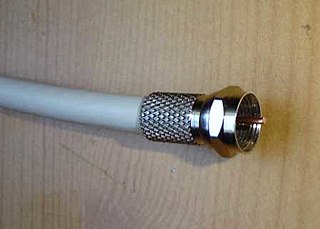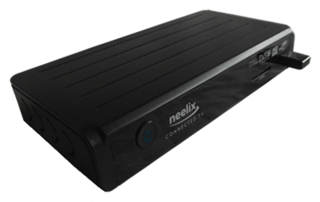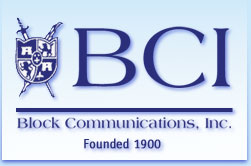
Cable television is a system of delivering television programming to consumers via radio frequency (RF) signals transmitted through coaxial cables, or in more recent systems, light pulses through fibre-optic cables. This contrasts with broadcast television, in which the television signal is transmitted over-the-air by radio waves and received by a television antenna attached to the television; or satellite television, in which the television signal is transmitted by a communications satellite orbiting the Earth and received by a satellite dish on the roof. FM radio programming, high-speed Internet, telephone services, and similar non-television services may also be provided through these cables. Analog television was standard in the 20th century, but since the 2000s, cable systems have been upgraded to digital cable operation.

A set-top box (STB), also colloquially known as a cable box, is an information appliance device that generally contains a TV-tuner input and displays output to a television set and an external source of signal, turning the source signal into content in a form that can then be displayed on the television screen or other display device. They are used in cable television, satellite television, and over-the-air television systems as well as other uses. A computer that connects to your television. Allows you to use telephone line or cable connection do you browse the Internet and exchange electronic mail on your television.

Terrestrial television is a type of television broadcasting in which the television signal is transmitted by radio waves from the terrestrial (Earth-based) transmitter of a television station to a TV receiver having an antenna. The term terrestrial is more common in Europe and Latin America, while in the United States it is called broadcast or over-the-air television (OTA). The term "terrestrial" is used to distinguish this type from the newer technologies of satellite television, in which the television signal is transmitted to the receiver from an overhead satellite; cable television, in which the signal is carried to the receiver through a cable; and Internet Protocol television, in which the signal is received over an Internet stream or on a network utilizing the Internet Protocol. Terrestrial television stations broadcast on television channels with frequencies between about 52 and 600 MHz in the VHF and UHF bands. Since radio waves in these bands travel by line of sight, reception is generally limited by the visual horizon to distances of 40–60 miles (64–97 km), although under better conditions and with tropospheric ducting, signals can sometimes be received hundreds of miles distant.
Advanced Television Systems Committee (ATSC) standards are an American set of standards for digital television transmission over terrestrial, cable and satellite networks. It is largely a replacement for the analog NTSC standard and, like that standard, is used mostly in the United States, Mexico, Canada, and South Korea. Several former NTSC users, in particular Japan, have not used ATSC during their digital television transition, because they adopted their own system called ISDB.
Digital cable is the distribution of cable television using digital video compression for distribution. The technology was developed by General Instrument, which was succeeded by Motorola and subsequently by ARRIS Group. Cable companies converted to digital cable during the 2000s, during the period that broadcast television converted to the digital HDTV standard, which was incompatible with existing analog cable systems. In addition to providing higher resolution HD video, digital cable systems provide more services such as pay-per-view programming, cable internet access and cable telephone services. Most digital cable signals are encrypted, which reduced the incidence of cable theft which occurred in analog systems.

Streaming television is the digital distribution of television content, such as TV shows, as streaming video delivered over the Internet. Streaming TV stands in contrast to dedicated terrestrial television delivered by over-the-air aerial systems, cable television, and/or satellite television systems. The use of streaming online video and web television by consumers has seen a dramatic increase ever since the launch of online video platforms such as YouTube and Netflix.

Internet Protocol television (IPTV) is the delivery of television content over Internet Protocol (IP) networks. This is in contrast to delivery through traditional terrestrial, satellite, and cable television formats. Unlike downloaded media, IPTV offers the ability to stream the source media continuously. As a result, a client media player can begin playing the content almost immediately. This is known as streaming media.
Superstation is a term in North American broadcasting that has several meanings. Commonly, a "superstation" is a form of distant signal, a broadcast television signal—usually a commercially licensed station—that is retransmitted via communications satellite or microwave relay to multichannel television providers over a broad area beyond its primary terrestrial signal range.
Datacasting is the broadcasting of data over a wide area via radio waves. It most often refers to supplemental information sent by television stations along with digital terrestrial television, but may also be applied to digital signals on analog TV or radio. It generally does not apply to data which is inherent to the medium, such as PSIP data which defines virtual channels for DTT or direct broadcast satellite systems; or to things like cable modem or satellite modem, which use a completely separate channel for data.

1080p is a set of HDTV high-definition video modes characterized by 1,920 pixels displayed across the screen horizontally and 1,080 pixels down the screen vertically; the p stands for progressive scan, i.e. non-interlaced. The term usually assumes a widescreen aspect ratio of 16:9, implying a resolution of 2.1 megapixels. It is often marketed as Full HD or FHD, to contrast 1080p with 720p resolution screens. Although 1080p is sometimes informally referred to as 2K, these terms reflect two distinct technical standards, with differences including resolution and aspect ratio.

The Filipino Channel, commonly known as TFC, is a 24-hour global subscription television network based in Daly City, California with studio in Redwood City, California and offices in Africa, Australia, Brazil, Canada, Cayman Islands, UAE, Ethiopia, Hungary, Israel, Japan, Europe, Mexico, Middle East, the Netherlands, New Zealand, South Africa and the United Kingdom. It is owned and operated by the Filipino media conglomerate ABS-CBN Corporation. Its programming is composed primarily of imported programs from the ABS-CBN television network.

Toledo 5, The CW was a cable channel serving Northwest Ohio, primarily serving the city of Toledo and Northwest Ohio. The channel was operated by Buckeye Cablesystem, and was originally exclusive to its subscribers, but expanded to other northwestern Ohio cable providers such as Time Warner Cable and Comcast. It was carried on channel 5 on Buckeye CableSystem and various other channel positions on Time Warner Cable and Comcast.

Block Communications Inc. is an American privately held holding company of various assets, mainly in the print and broadcast media, based in Toledo, Ohio. The company was founded in 1900 in New York City when Paul Block, a German-Jewish immigrant who came to the United States fifteen years prior, formed an ad representation firm for newspaper the Block empire grew to encompass many newspapers on the east coast of the US, however with the Great Depression in the 1930s came the loss of all but three properties: the ad representation firm, the Pittsburgh Post-Gazette, and the Toledo Blade. After Block's death in 1941, his children took over the company and later his grandchildren.
In broadcasting, digital subchannels are a method of transmitting more than one independent program stream simultaneously from the same digital radio or television station on the same radio frequency channel. This is done by using data compression techniques to reduce the size of each individual program stream, and multiplexing to combine them into a single signal. The practice is sometimes called "multicasting".
Cable television first became available in the United States in 1948. Data by SNL Kagan shows that as of 2006 about 58.4% of all American homes subscribe to basic cable television services. Most cable viewers in the U.S. reside in the suburbs and tend to be middle class; cable television is less common in low income, urban, and rural areas.
BCSN is a regional sports network founded in 2003 to carry sports broadcasting, which had previously been aired on fellow cable-only station WT05.
Buckeye Broadband is a cable and telecommunications provider located in Toledo, Ohio, United States, that is owned by Block Communications. Buckeye Broadband provides cable television, broadband internet and home telephone services to customers in northwest Ohio and parts of southeast Michigan; in addition to its system in Toledo, Buckeye also provides services to Sandusky and Erie County in north central Ohio, which were formerly served by predecessor Erie County Cablevision.
VMedia Inc. is a Canadian telecommunications company and broadcast distribution provider. It offers VoIP telephone and home security services across Canada; DSL and cable Internet in Ontario, Quebec, Manitoba, Saskatchewan, Alberta, and British Columbia; and IPTV television service in Ontario, Quebec, Alberta and British Columbia.
An over-the-top (OTT) media service is a streaming media service offered directly to viewers via the Internet. OTT bypasses cable, broadcast, and satellite television platforms, the companies that traditionally act as a controller or distributor of such content. It has also been used to describe no-carrier cellphones, where all communications are charged as data, avoiding monopolistic competition, or apps for phones that transmit data in this manner, including both those that replace other call methods and those that update software.
Vision IPTV is a niche internet TV and IPTV company located in London. The business offers a white label, broadcast standard, over the top internet TV platform service, based on the server technology developed by sister company Playout247, who provide satellite playout services which deliver channels to SKY and other satellite operators. Vision IPTV is based in central London. In February 2011 Vision IPTV opened an office in Dubai. The company has a corporate responsibility programme and supports several charities including Human Being Best.









